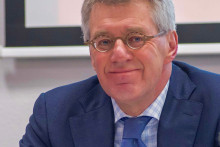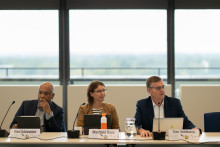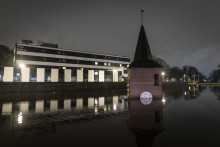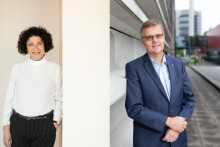Declining student numbers, lack of focus, mass and cohesion in education and research, lack of international orientation, organisational fragmentation and a considerable overhead of support staff. We are talking about the late nineties of the last century. The future of the UT was worrisome, Van Vught thought when he took office as rector.
'Of course, the external circumstances were different at the time', the former administrator outlines the situation at the time, from his office in Usselo. An office that he regularly exchanges for his office in the fifteenth-century monastery in Florence, where he is director of the 'European University'. 'At the end of the 1990s, there was talk of a withdrawing government and a strong competition between the universities themselves, in which the UT lagged behind. We had a marginal position and our profile was lackluster. On top of that, we had to deal with a real estate issue; on 1 January 1995, the UT had become the owner of all the real estate on campus, but almost all the buildings were at the end of their lifespan. We were struggling with heavy overdue maintenance and there were major safety and asbestos risks.' There were also concerns about the ever-declining student numbers. And in the area of research funding, very little was obtained. Van Vught: 'In the 'depth strategy' (second money stream, ed.), the UT had not scored at all; Delft and Eindhoven did.'
In short, there was a lot of work to be done. And that is why we can draw a comparison with the current situation.
What was the biggest pain point at the time?
'Redesigning education and research was the most difficult part. But financially, it was the real estate. In the end, we were able to take out a loan with a consortium of banks for the renovation of the property, as well as for new construction, such as the new cleanroom. However, given the declining education and research income, this did lead to the need for a reorganisation.’
What did that reorganisation look like?
'We developed four lines of action, which together represented a new strategic profile for the UT. This strategic profile was given the name 'Hartslag' (‘Heartbeat’, ed.). The academic heart had to become stronger. The four lines were; Strengthening education and research, reorganisation of the faculties, restructuring of service departments and the real estate plan.
First of all, the position of students as members of our academic community should be strengthened for the educational profile. This led, among other things, to the establishment of the Student Union; I still look back on that with pride. We also introduced the 'major/minor' principle in education, an educational innovation that has since been adopted by all universities and universities of applied sciences. Another line was the development of new study programmes, and of a 'third core' in addition to the technical and social sciences. In just a few years, the UT has added a number of new programmes: Biomedical Engineering, Technical Medicine, Health Sciences, Business Information Technology, Industrial Design Engineering and Psychology.'
What was the result at the time?
'It attracted new students fairly quickly. And we became visible; in 1998 we were 'best university in the Netherlands' for the first time, according to Elsevier. We managed to hold on to that title for a number of years in a row.'
'It was difficult, but also inevitable'
What else happened?
'In the field of research, the idea was that the many small research groups should be more interconnected and that there should be an increase in scale and prioritisation. This led to the formation of the 'spearhead institutes', including MESA+ and CTIT. Together with leading scientists and advisors, a so-called portfolio analysis was drawn up at the time to underpin the formation of spearheads. We also wanted to become the 'entrepreneurial university 2.0'. That led to the Kennispark Twente and a large increase in the number of spin-offs, which at the time were the most of all Dutch institutions.'
'And a crucial part of the reorganisation was, of course, the faculty reorganisation. We went from ten to five faculties. This led to a strengthening of the faculty boards, and to a more integrated central board, in particular through the establishment of the 'central management team'.
But that also resulted in layoffs?
'The merger of faculties meant that some functions became redundant. The restructuring of service departments also played a role in this. Some service departments were terminated and others were merged. That wasn’t a pleasure at all, and even threatening at times. But there was also a redundancy plan, and in the end, most of the redundancies were absorbed through natural attrition and a hiring freeze. Yes, I've been awake at night thinking about that. It was difficult, but also inevitable.'

How did you ensure support?
'By talking a lot, and repeating the message. The note Hartslag implied a new perspective. That's what we were trying to convey. Fortunately, it also led to enthusiasm and support, such as for the establishment of the spearhead institutes; They offered great new opportunities for many researchers.'
Did the UT emerge stronger from that reorganisation?
'Yes, I think so. Stronger, more powerful in terms of content. The UT was given a new profile; More reputable research was created, more students came and activities grew.'
As a former rector and president of the Executive Board, how do you view the current financial misery?
'The financial problem is a sum of various things. And that is comparable to the situation in the late nineties. At the time, we believed that if you want to solve the financial problems, you have to dare to look into the heart of the university. Fortunately, there is no real estate problem now. But I can imagine, for example, that the support services are in need of an analysis again, adapted to the requirements of our time. And generally speaking, I think the UT is ready for the next phase of its existence.'
'The UT has matured'
Have you ever been asked for advice by the current Executive Board because of your expertise as a former administrator?
‘No, that never happened. And of course I'm reluctant to reach out and give unsolicited advice.'
What do you notice when you look at the UT?
'Above all, I look at the UT with a lot of nostalgia. It's the university with the most beautiful campus, and I've seen a lot of them. There are also a lot of my footprints. I see a modern university, but also a university like any other. The UT has matured. But the distinction we used to have in the field of innovative education, cutting-edge research and entrepreneurship is no longer there.'
What lessons can we learn from that period?
'First of all, to see challenges not as a problem, but as an opportunity. It takes guts and courage to do that. It is also important to want to tackle the problems together. And for that, you need to develop a vision. The substantive initiative for this lies with the Executive Board and with the deans and directors. But such a vision should not only be abstract, you should have the courage to take the plunge towards concrete changes.'
'Some people might have been happy when I left in 2005'
Looking back, what do you wish you had done differently?
‘I may have pushed or pulled too hard at times. This was sometimes at the expense of public support. I consider myself lucky to have had the support I've had from many, but I know that because of all that pushing and pulling, some people came to dislike me. There were plenty of positive noises though; At least something happened. And yes, some of them might have been happy when I left in 2005.
I see it as the duty of a director to guide the institution to the next phase of life. You have that responsibility. You also need a thick skin and perseverance.'
So if there's one thing you'd like to give today's UT administrators as unsolicited advice, what is it?
'Then I would say: think again about the next phase of our profile.'
Profile Frans van Vught
Frans van Vught (1950) studied urban planning and sociology at Utrecht University and urban planning at MIT, in the USA. He was affiliated with American universities (UCLA, University of Colorado) for several years and then became a professor in Leiden and at the UT. Van Vught was rector and president of the UT in the period from 1996 to 2004.
In it, he implemented important innovations for the UT. These included the establishment of the Industrial Design Engineering, Biomedical Engineering, Technical Medicine, Health Sciences, Psychology and Applied Technology programmes, the merger of ten faculties into five and the formation of UT research institutes. The development and the first phases of the UT real estate plan also date from his period.
After his departure, Van Vught became a top advisor at the European Commission in Brussels and received several honorary doctorates. He was named the most influential figure in higher education by ScienceGuide in 2008. Since 2022, he has been president of the European University Institute in Florence. Van Vught still lives in Twente.






